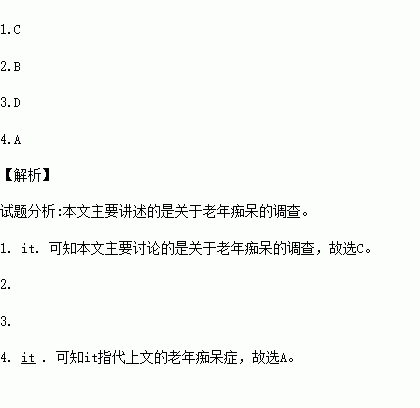题目内容
Alzheimer's disease(老年痴呆症)affects millions of people around the world. American researchers say the disease will affect more than one hundred million people worldwide by the year twenty fifty. That would be four times the current number. Researchers and doctors have been studying Alzheimer's patients for a century. Yet the cause and the cure for the mental sickness are still unknown. However, some researchers have made important steps towards understanding it.
Several early signs of the disease involve memory and thought processes. At first, patients have trouble remembering little things. Later, they have trouble remembering more important things, such as the names of their children.
There are also some physical tests that might show who is at risk of developing Alzheimer's disease. The tests look for proteins in brain and spinal cord(脊髓) fluid. The proteins appear to be found only in people with the disease. The protein tests correctly identify the presence of the disease in about ninety percent of patients.
Now, a much simpler physical test to predict Alzheimer's risk has been developed. Researchers found that trouble with the sense of smell can be one of the first signs of Alzheimer's. Using this information, they developed a test in which people were asked to identify twelve familiar smells. These smells included cinnamon, black pepper, chocolate, paint thinner, and smoke.
The study continued for five years. During this period, the same people were asked to take several tests measuring their memory and thought abilities. Fifty percent of those who could not identify at least four of the smells in the first test had trouble with their memory and thinking in the next five years.
Another study has shown a possible way to reduce a person's chances of developing Alzheimer's disease in old age. Researchers in Chicago found that people who use their brains more often are less likely to develop Alzheimer's disease. Those who read a newspaper, or play chess or word games are about three times less likely to develop the condition.
Researchers say they still do not know what causes Alzheimer's disease. But they say these findings might help prevent the disease in the future.
1. What?s the main idea of the passage?
A. Some early signs of the Alzheimer's disease.
B. Some physical tests about Alzheimer's disease.
C. The research about Alzheimer's disease.
D. The patients of Alzheimer's disease.
2.What?s the current number of Alzheimer?s patients?
A. 100 million B. 25 million
C. 400 million D. 2050 million
3.What is not the early signs of the Alzheimer's disease according to the passage?
A. Poor memory
B. Proteins exist in the brain.
C. Trouble with the sense of smell.
D. Less use of the brain.
4.What does the underlined word it in paragraph 1 refer to?
A. Alzheimer's disease. B. Alzheimer's patients.
C. The cause and the cure. D. The research.
假如你叫李华,今年暑假即将跨入高三的学习,压力很大,想和父母说说心里话,请你用英文在你的博客上用书信形式表达出来。主要内容如下:
知心话 | 感恩 | 感谢父母的关心、鼓励 |
对父母的期望 | 1. 多加交流2. 适时提供帮助 | |
学习打算 | 考生自拟(至少写两点) | |
注意:1. 短文必须包括所有内容要点,可适当发挥。
2. 词数:120左右(开头与结尾已给出,不计入词数)
Dear Mom and Dad,
With the Senior Three approaching, I really hope to have a heart-to-heart talk with you!
____________________________________________________________________
____________________________________________________________________
____________________________________________________________________
Mom and Dad, I am quite confident about my future. Wish you good health and a happy life.
Yours sincerely,
Li Hua

